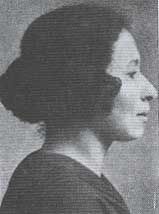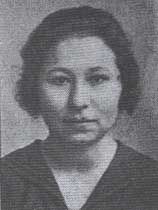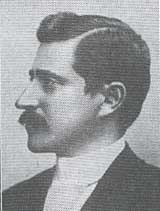Hans Günther - The racial elements of European history
THE RACIAL ELEMENTS OF EUROPEAN HISTORY
Chapter
IV
Part One
RACIAL
STRAINS FROM OUTSIDE EUROPE
The Hither Asiatic [ΠΡΟΣΩ ΑΣΙΑΤΙΚΗ]
race
IN
the second chapter we dealt only with those bodily characteristics which show
themselves especially clearly in the outward appearance, that is to say, with
some only of the outwardly visible hereditary bodily attributes. Besides other
visible characteristics, therefore, hereditary racial characteristics within the
body were also left undealt with; these last we are still unable to consider
even to-day, for a beginning has hardly yet been made with them. Here, too, we
can only just refer to the peculiarities of movement in the various races, and
to racial blood analysis.l
Besides those
hereditary elements which can be recognized or at least surmised in the European
population as coming from one of the European races, there are also
characteristics that are not yet ascribed to any European race or to a racial
strain from outside Europe, and are, perhaps, not true racial marks, or are
marks which occur in several races: among such may be mentioned the epicanthus
and the so-called Mongolian spot.
In the case of the
Mongolian fold, where this is found at times in Europeans an Inner Asiatic
(Mongolian) strain may be generally suspected; where there is very frizzly hair
we may suspect a Negro strain.
In Eastern Europe,
as, too, in Hungary and the Balkans, whither tribes of Asiatic origin have ever
been penetrating, an Inner Asiatic strain can be seen, growing more and more
evident as we go eastwards.
This strain is to
be found, too (through Lappish blood), in northern Finland, Sweden, and Norway
(cp. Figs. 144 and 145).
A Negro strain is
found from olden times all over the Mediterranean area (Negroes in the Roman
army, Negro slaves), especially in the shipping towns since the Crusades.
Negroes were, and still are, the fashion as servants in the big towns. Marriages
with Southern Europeans have brought Negro blood into Central Europe; Italian
navvies, particularly, have often shown a more or less evident Negro strain.
Into France Negro blood has made its way from the French territories in Africa.
Portugal, owing to the former importation of slaves from Africa, shows a
particularly well-marked Negro strain.2 To-day it is first and
foremost French policy that is intensifying the 'Black Peril' for the whole
world by giving the Negro, through the granting of full civil rights and
officer's rank, an influence whose full results we cannot yet see.3
For Germany the French domination involves the 'Black Shame,' whose results,
too, cannot be foreseen -- the attacks by Africans on white women in the
occupied territory. Distler in his book, Das deutsche Leid am Rhein. Anklagen
gegen die Schandherrschaft des französischen Militarismus (1921), has to say
that: 'It is beyond all doubt that the birth-rate of cross-breeds is steadily
rising.'
A Malay strain,
arising from the mixed unions which have been customary among the Dutch in their
colonies since the seventeenth century, is to be seen unmistakably in the towns
of Holland.
 |
 |
| Fig. 144 - Yakut Woman, Inner Asiatic Race | Fig. 145 - Gilyak from the Chaivinsky Gulf, Inner Asiatic Race |
 |
 |
| Fig. 146 - Holland, Van Haanen, painter, Nordic with Malay strain |
Fig. 147 -
Dahomey Negro
|
 |
 |
| Fig. 148 - Russia, Tartar, Inner Asiatic with East Baltic strain | Fig. 149 - Magyar (Szekler) woman, predominantly Inner Asiatic |

 |
|
Figs. 150a,
150b - Transylvania, Inner Asiatic-Dinaric, or Inner Asiatic-Hither Asiatic
|
|
From the Caucasus
and Asia Minor there reaches as far as the Balkans a fairly strong strain of the
Hither Asiatic race. This strain is recognizable, too, in Spain and southern
Italy. In Spain and southern Italy, particularly in Sicily, there are slight
Oriental racial strains. These two races are strongly represented in the mixed
blood of the Jews. In the gipsies, too, they are both present.
 |
||
Fig. 151 -
Skull from Asia Minor, Hither Asiatic Race
|
||
 |
 |
 |
Fig. 152 - Imeretian from Kutais, Hither Asiatic Race
|
Fig. 153 - Armenian, Hither Asiatic Race
|
Fig. 153a - von Heidenstam, Nordic-Hither Asiatic
|
The Hither Asiatic [ΠΡΟΣΩ ΑΣΙΑΤΙΚΗ]
race must be considered as a branch of the Dinaric. Both have so many marks in
common that there has been a tendency to look on them as a single human group.
The Hither Asiatic race is of middling height, and thick-set; the head is short
and rises straight up at the back; the face is narrow, with a very prominent
nose, which sinks downward at the cartilage and has a fleshy lower end; the lips
are rather full; the hair is brown or black, generally curly, often too, it
would seem, frizzly; the eyes are brown; the skin is brownish. Both the body
hair and the beard grow very strong. The eyebrows are thick, and often meet
above the nose. Compared with the Dinaric race the chin is less prominent, and
lies farther back; a line drawn from the upper lip to the chin is characteristic
for the profile of the Hither Asiatic race. The line from the ear to the
cheek-bones runs somewhat more downwards than in the other races here
considered. If the expression of the Dinaric face may be called bold, that of
the Hither Asiatic is cunning. In their mental qualities these two races, which
have so great a bodily likeness, show a good deal of difference. In the Hither
Asiatic man there is a striking gift for trade, more than ordinary powers of
reading character and understanding human nature, and a tendency to deliberate
cruelty, combined with musical and histrionic ability. 'Not so much an energetic
spirit of enterprise as a watchful reserve, not so much a proud self-reliance as
a crafty spirit of calculation is what speaks out from their eyes'; this is
Stiehl's excellent picture of the Armenian prisoners of war of Hither Asiatic
race.4 The Caucasus is the area where the Hither Asiatic race is most
predominant. The original languages of this race are the Caucasian (Alarodic).
 |
 |
Fig. 154 -
Arab from South Algeria (sharply bent nose), according to Weninger C, 76.64, F, 98.52
|
Fig. 155 - Assyrian, the nose is bent in the last third, characteristic shape of the lips
|
 |
 |
Fig. 156 -
Mummy portrait from Egypt, Second Century AD, characteristic shape of the
lips
|
Fig. 157 - Georgian, Hither Asiatic strain
|
 |
 |
Fig. 158 -
Arab Sheikh from Palmyra
|
Fig. 159 -
Arab from the Algerian Sahara
|
The Oriental race,
which is found as a slight strain in Southern Europe, is short to middling
height, slender, long-headed, and narrow-faced. The nose is narrow, or curved in
the lower third (Fig. 155), less often sharply curved in the upper third (Fig.
154), and not very prominent, being sometimes rather flat; now and again it has
a somewhat deep-lying, though narrow, root (Fig. 158). The lips are slightly
swollen, often, as it were, arched and pointed in a smile. The deep groove (sulcus
mentalabialis) between the under lip and the chin often lies higher than in
other races (Fig. 156); this gives a characteristic look to the face of the
Oriental race. The under lip as a result sometimes leaves the impression of
being slightly protruded, as it probably often is. The skin is rather fair; it
often looks fairer than that of the Mediterranean race, but with a fairness
which is pale, not rosy. The hair is dark brown or black, and usually curly. The
eyes are very dark. They are often almond-shaped, that is to say, the inner
corners are rounded, while the outer corners come more to a point, the opening
between the lids rising slightly in the outward direction. The eyes often have a
sunken look.
The Oriental race
is probably akin to the Mediterranean. Its original home seems to have been
Arabia in the Diluvial Age, when this was still a fertile area. The Arabian
Bedouin still show the strongest Oriental strain. The Semitic tongues belonged
originally to the Oriental race. Owing to tribes of Oriental race having spread
these tongues far and wide, they are spoken to-day by many whose blood belongs
to other races.
 |
 |
Fig. 160 -
Russia, Lermontov, Poet, 1814-41, Oriental-Dinaric
|
Fig. 161 -
Rumania, Oriental
|
 |
 |
Fig.
162 - Turk from Smyrna, Oriental with Hither Asiatic strain
|
Fig. 163 -
Netherlands, Van Dyck, Painter (self-portrait), Nordic with Oriental strain
|
Oriental and
Hither Asiatic blood has been spread from the East over the whole of
South-eastern Europe, above all in the lands around the Black Sea and in the
Balkans, and also wherever Islam has been carried, especially, therefore, in
Spain. Through unions with Southern Europeans the blood of the Oriental and of
the Hither Asiatic race has sometimes made its way, too, to Central and Northern
Europe. The fact of there being a strain of these races in a Central or Northern
European does not, then, always point to a Jewish connexion (cp. Fig. 163).
Over and above
strains of blood from outside Europe, such as the foregoing, it may well be that
occasionally characteristics of prehistoric European races will be traceable,
when investigations are once begun in this direction. Possibly, for example,
among criminals there is a somewhat greater frequency of characteristics of the
Neanderthal race; so that, for example, a low retreating forehead, or underhung
jaws, and a small brain-chamber in the skull would not always have to be
interpreted as signs of degeneration only, but in many cases as characters
inherited from this prehistoric race and sprinkled throughout the population;
which characters might easily show themselves on the mental side in criminal
tendencies.
In Scotland a
strain of the palaeolithic Crô-magnon race has been suspected, as also in Norway
in the Drontheim district,5 in Sweden in the Dalarna province, in
Germany in Westphalia.6 I am inclined to believe in the probability
of a strain of this race (with fair hair and skin, and light eyes?) for
Westphalia, and an area from Westphalia to West Thuringia. The race we are
speaking of is very tall -- tall and broad, not tall and slender; broad-faced
and long-headed; by some it is held to be dark-haired and dark-eyed, others hold
that it is fair. In Norway, and thence derivatively in Iceland7 -- as
also it would seem in Scotland -- we have to do with a strain from a
dark-haired, dark-eyed race; in Dalarna perhaps only with the results of a
Nordic-East Baltic cross.
Footnotes for
Chapter IV Part One
1
On these points cp. Rassenkunde des deutschen Volkes. On blood analysis
and other departments of research in racial physiology, cp. Basler, Rassen-
und Gesellschaftsphysiologie, 1925.
2
In America it is believed that any admixture of Negro blood can be recognized by
the colouring of the white of the nails. This crescent-shaped mark at the bottom
of the nail which in the European races is white, is said to show a bluish tinge
for many generations after a mingling of Negro blood.
3
On the dangers, equally great for the European and the American peoples, of the
French policy towards the natives of Africa, cp. the following articles: 'Die
schwarze Weltgefahr,' by Widenbauer; and 'Wesen und Zweck der französischen
Koloniepolitik,' by v. Oefele (both in Deutschlands Erneuerung, 1923,
Heft 12). Cp. also the book of Larsen (a Dane), Der flug des Adlers über den
Rhein und den Äquator, 1925, which deserves to be circulated especially in
Germany. On the Black Peril in general, see Stoddard, The Rising Tide of
Colour against White World-Supremacy, 1920. That in France, too, there are
glimpses of the danger can be seen by what Le Temps wrote on 26th April
1923: 'In the Roman Empire towards its end the legions were replaced by
barbarian hordes. We know what that cost.'
4
Stiehl, Unsere Feinde, Characterköpfe aus deutschen
Kriegsgefargenenlagern, 1916.
5
Bryn, 'En Nordisk Crô-magnontype,' Ymer, 1921.
6
Hauschild, 'Zur Anthropologie der Crô-magnonrasse.' Zeitschr. für
Ethnol., Heft I-4. 1923.
7
Hanneson, Körpermasse und Körperproportionen der Isländer, Reykjavik,
1925.
http://www.theapricity.com/earlson/reeh/reoehchap4a.htm
======================
http://www.theapricity.com/earlson/reeh/reoehchap4a.htm
======================



No comments:
Post a Comment